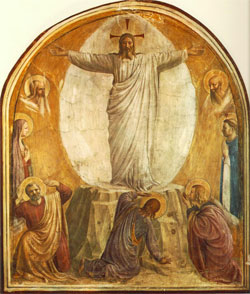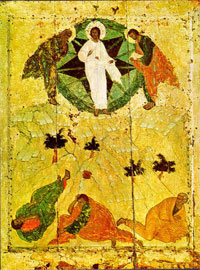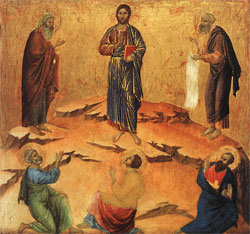Listen to Him:
The Transfiguration of Jesus
For Sunday February 26, 2006
Lectionary Readings (Revised Common Lectionary, Year B)
2 Kings 2:1–12
Psalm 50:1–6
2 Corinthians 4:3–6
Mark 9:2–9
 |
Transfiguration, Fra Angelico, Italy (1400–1455). |
In the Gospel this week we read about the "transfiguration" (Greek, metamorphosis) of Jesus, a story so central to the Gospel that all three synoptic writers include it (Matthew 17:1–8 = Mark 9:2–10 = Luke 9:28–36):
After six days Jesus took Peter, James, and John with him and led them up a high mountain, where they were all alone. There he was transfigured before them. His clothes became dazzling white, whiter than anyone in the world could bleach them. And there appeared before them Elijah and Moses, who were talking with Jesus. Peter said to Jesus, "Rabbi, it is good for us to be here. Let us put up three shelters—one for you, one for Moses and one for Elijah." (He did not know what to say they were so frightened). Then a cloud appeared and enveloped them, and a voice came from the cloud: "This is my Son, whom I love, listen to him!" Suddenly, when they looked around, they no longer saw anyone with them except Jesus. As they were coming down the mountain, Jesus gave them orders not to tell anyone what they had seen until the Son of Man had risen from the dead. They kept the matter to themselves, discussing what "rising from the dead" meant.
 |
Transfiguration, Solomon Raj, India, batiq. |
Some readers will dismiss this story out of hand as bizarre fiction. Others will purge it of perceived offensive elements while trying to retain some kernel of truth—for example, interpreting the incident as an embellished tale, as a truth communicated by myth or metaphor, or even as a misplaced and reinterpreted account of the resurrection. But I like the advice of Harvey Cox who cautioned against encountering the "sweeping vision" of Christian eschatology only to "whittle it down to something manageable and lackluster" (When Jesus Came to Harvard).
Years later Peter remembered this terrifying experience precisely to counter ridicule that the early believers followed "cleverly invented stories" as opposed to "eyewitness" accounts of actual events (2 Peter 1:16–18). The details of the story—exactly six days after Peter's confession that Jesus is the Christ (Mark 8:27–30), the identification of Mount Hermon in present-day Syria which reaches 9,000 feet, the secluded and private nature of the incident, the palpable terror they experienced, Peter's impulsive outburst, and their confusion about something so essential as the resurrection from the dead—all these suggest that Mark intended his readers to understand that he was writing history and not myth or metaphor, even if the story, like so many stories in the Gospels, is easier to describe than to explain.
 |
Transfiguration, Andrei Rublev, Russia (1405). |
Even if the nature of the transfiguration is not obvious, Mark seems to report a genuine experience. Sometimes even the recipient of such an experience is hard-pressed to describe exactly what happened. Luke, for example, records how in Peter's miraculous escape from prison he "had no idea that what the angel was doing was really happening; he thought he was seeing a vision" (Acts 12:9). Whether Peter, James and John had an ecstatic vision, or whether Jesus was literally if briefly "metamorphosized" before their very eyes (more likely, in my mind), the natural, physical phenomenon of brilliant light is secondary to the supernatural, metaphysical affirmation of the voice from the cloud—this Jesus whom the disciples followed was not just an itinerant rabbi, clever sage, socio-political provocateur, subversive wisdom teacher, ascetic, or failed apocalyptic troublemaker. The transfiguration portrays him as the Cosmic Lord of all human history, and God's beloved and specifically appointed Son. Having thus experienced a fleeting glimpse and foretaste of the full and final consummation of all things, the conclusion is inevitable: "Listen to him."
Three marvels accompanied the transfiguration. First, Jesus's clothes radiated blinding light. Matthew's version likens this radiance to the brilliance of the sun (Matthew 17:2). Both descriptions evoke comparisons to Moses on Mount Sinai when Yahweh appeared to him in a cloud and consuming fire (Exodus 24). Paul described his famous conversion on the road to Damascus as an encounter with blinding light accompanied by a voice from heaven (Acts 22:6, 26:13), which testimony lends an experiential aspect to his declaration that God "dwells in unapproachable light" (1 Timothy 6:16). Then, Moses and Elijah appear. In his transcendent glory Jesus fulfills the law that Moses received, and consummates the end of all things that Elijah was thought to harbinger (Mark 9:11). Third, the voice of God the Father from a cloud, reminiscent of that at his baptism (Mark 1:11), affirms what only a few pages earlier Peter had confessed, that Jesus is God's beloved and specially appointed Son who merits our total allegiance: "Listen to him!"
 |
Transfiguration: Bertrand Bahuet, France, fresco, (1995–1996). |
Nothing is easier for Christians who have become over-familiar with the Gospel texts and traditions than to domesticate and diminish them—taming the ineffable, trivializing the indescribable, cutting and trimming to neuter God so as to manage him. In their social-scientific survey of 3,290 teenagers (ages 13–17) and parents, and 267 personal interviews, conducted across four years (2001–2005), Christian Smith (the Stuart Chapin Distinguished Professor of Sociology at UNC and a committed Christian) and his colleague Melinda Lundquist Denton conclude that adults have effectively communicated to kids what they call a "Moral Therapeutic Deism:" be nice, don't do bad, for a remote deity wants you to be happy and feel good about yourself." In other words, says Smith, "we have come with some confidence to believe that a significant part of 'Christianity' in the U.S. is actually only tenuously Christian in any sense that is seriously connected to the actual historical Christian tradition."1
 |
Transfiguration: Duccio di Buoninsegna, Italy (1308–1311). |
The transfiguration of Jesus belies the ways we dilute the stringent wine of the Gospel. The blinding light and voices from the clouds challenge faith that has turned tepid, perfunctory, and even boring. In her book Teaching a Stone to Talk, Annie Dillard thus asks:
Does anyone have the foggiest idea of what sort of power we so blithely invoke? Or, as I suspect, does no one believe a word of it? The churches are children playing on the floor with their chemistry sets, mixing up a batch of TNT to kill a Sunday morning. It is madness to wear ladies' straw hats and velvet hats to church; we should all be wearing crash helmets! Ushers should issue life preservers and signal flares; they should lash us to our pews! For the sleeping God may awake someday and take offense, or the waking God may draw us to where we can never return.
I can understand how some people will read the transfiguration story and as Dillard admits "not believe a word of it." But God save us from the safe middle ground of self-serving, domesticating deism.
For further reflection:
* How do we "whittle down" (Cox) accounts like the transfiguration? Why?
* Consider the many ways we trivialize the Gospel and "domesticate" God.
* Based upon your own experience, what do you make of the conclusions of Smith and Denton?
* Why do you think Jesus gave Peter, James and John orders not to tell anyone what they had seen until he had risen from the dead?
* For further study, see Donald McCullough, The Trivialization of God; The Dangerous Illusion of a Manageable Deity (1995).
[1] See their ground-breaking National Study of Youth and Religion funded by the Lilly Endowment, the results of which are published in their book Soul Searching: The Religious and Spiritual Lives of American Teenagers (Oxford University Press, 2005).





